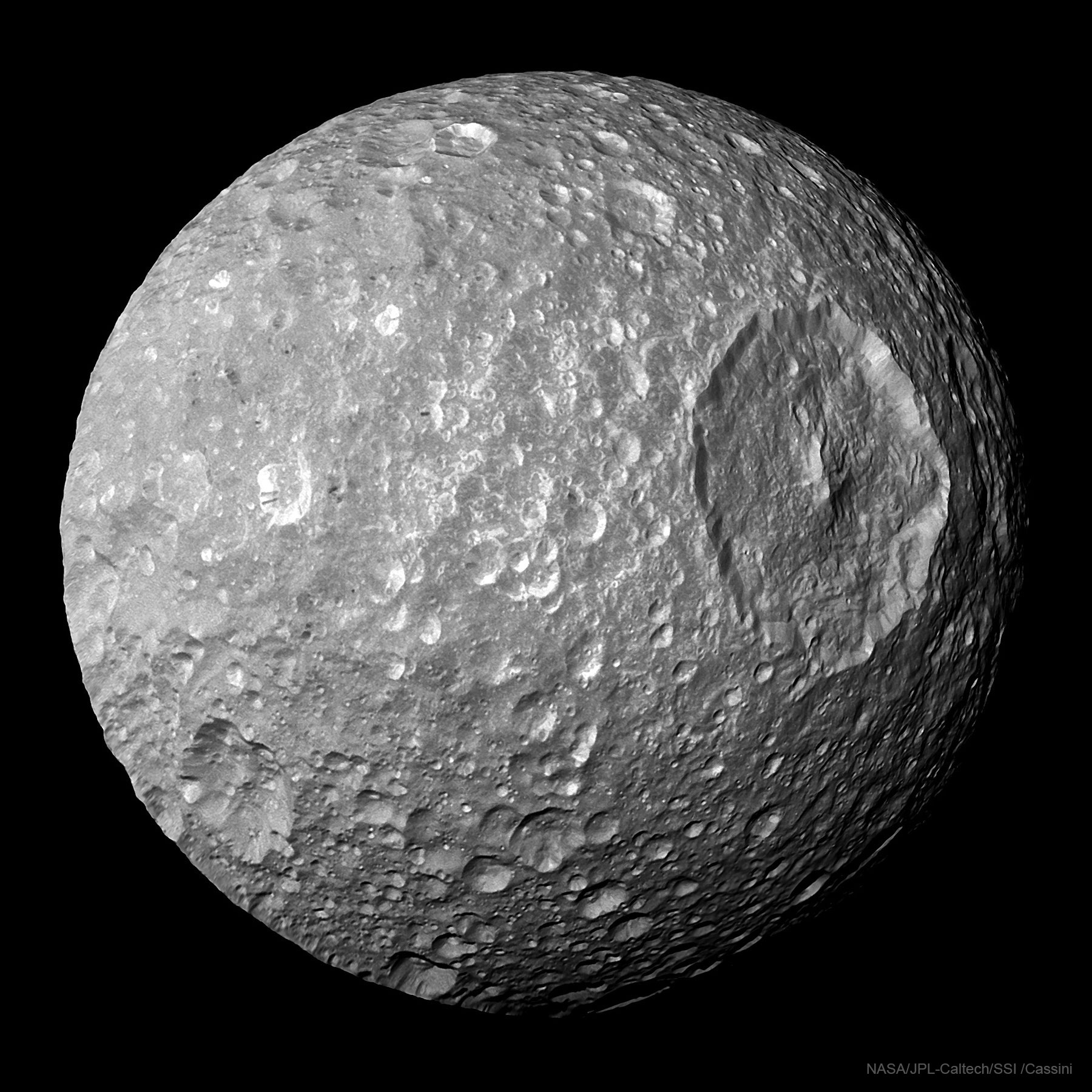31. May 2021
Mimas:有大隕石坑 ê 細粒衛星

探索宇宙1!逐工會揀一幅無仝款 ê 影像抑是相片,𤆬你熟似咱這个迷人 ê 宇宙,閣有專業天文學者2為你解說3。
- 原始文章:Mimas: Small Moon with a Big Crater
- 影像來源 kah 版權:NASA, JPL-Caltech, Space Science Institute, Cassini
- 互動模式:來 Mimas 行看覓!
- 台文翻譯:An-Li Tsai (NCU)
[漢羅] Mimas:有大隕石坑 ê 細粒衛星
毋管是 siáng kah Mimas 相碰,攏會 kā 伊挵甲 giōng 欲碎–去。 這是 土星 一粒上細粒 ê 球形衛星面頂,其中一擺 上大相碰產生 ê 隕石坑。 分析了後發現,若是閣較強一點仔 ê 相碰, to̍h 會 kā Mimas 規粒挵碎。 這个大隕石坑是 tī 1789 年 tī Mimas 發現 ê,叫做 Herschel,是用 William Herschel 爵士 ê 名號–ê。 這粒有 130 公里闊 ê 隕石坑 to̍h tī 遮。 低質量 ê Mimas 產生 ê 表面重力,拄仔好強到有法度結做一粒 球形天體,嘛拄仔好弱到有法度產生這款大型 ê 表面結構。 Mimas 大部份 ê 成份是水冰 kah 一寡岩石。 所以講伊是一粒大粒 ê 垃圾雪球,實在是真鬥搭。 這張影像是 Casiini 機器人太空船 tī 2010 年 踅土星 leh 行 ê 時陣,飛過 Mimas 上近彼陣翕 ê。
[POJ] Mimas: Ū tōa ún-se̍k-kheⁿ ê sè-lia̍p ūi-chhiⁿ
M̄-koán sī siáng kah Mimas sio-pōng, lóng ē kā i lòng-kah giōng beh chhùi–khì. Che sī Thó͘-chhiⁿ chi̍t-lia̍p siōng sè-lia̍p ê kiû-hêng ūi-chhiⁿ bīn-téng, kî-tiong chi̍t-pái siōng-tōa sio-pōng sán-seng ê ún-se̍k-kheⁿ. Hun-sek liáu-āu hoat-hiān, nā-sī koh-khah kiông chi̍t-tiám-á ê sio-pōng, to̍h ē kā Mimas kui-lia̍p lòng-chhùi. Chit-ê tōa ún-se̍k-kheⁿ sī tī it-chhit-pat-kiú nî tī Mimas hoat-hiān ê, kiò-chò Herschel, sī iōng William Herschel Chiok-sū ê miâ hō–ê, ū chi̍t-pah-saⁿ-cha̍p kong-lí khoah. Kē chit-liōng ê Mimas sán-seng ê piáu-bīn tiōng-le̍k, tú-á-hó kiông kàu ū-hoat-tō͘ kiat-chò chi̍t-lia̍p kiû-hêng thian-thé, mā tú-á-hó jio̍k kàu ū-hoat-tō͘ sán-seng chit-khoán tōa-hêng ê piáu-bīn kiat-kò͘. Mimas Tōa-pō͘-hūn ê sêng-hūn sī chúi-peng kah chi̍t-kóa giâm-chio̍h. Só͘-í kóng i sī chi̍t-lia̍p tōa-lia̍p ê lah-sap soat-kiû, si̍t-chāi sī chin tàu-tah. Chit-tiuⁿ iáⁿ-siōng sī Casiini ke-khì-lâng thài-khong-chûn tī jī-khòng-it-khòng nî se̍h Thó͘-chhiⁿ leh kiâⁿ ê sî-chūn, poe-kòe Mimas siōng-kīn hit-chūn hip–ê.
[KIP] Mimas: Ū tuā ún-si̍k-khenn ê sè-lia̍p uī-tshinn
M̄-kuán sī siáng kah Mimas sio-pōng, lóng ē kā i lòng-kah giōng beh tshuì–khì. Tse sī Thóo-tshinn tsi̍t-lia̍p siōng sè-lia̍p ê kiû-hîng uī-tshinn bīn-tíng, kî-tiong tsi̍t-pái siōng-tuā sio-pōng sán-sing ê ún-si̍k-khenn. Hun-sik liáu-āu huat-hiān, nā-sī koh-khah kiông tsi̍t-tiám-á ê sio-pōng, to̍h ē kā Mimas kui-lia̍p lòng-tshuì. Tsit-ê tuā ún-si̍k-khenn sī tī it-tshit-pat-kiú nî tī Mimas huat-hiān ê, kiò-tsò Herstsel, sī iōng William Herstsel Tsiok-sū ê miâ hō–ê, ū tsi̍t-pah-sann-tsa̍p kong-lí khuah. Kē tsit-liōng ê Mimas sán-sing ê piáu-bīn tiōng-li̍k, tú-á-hó kiông kàu ū-huat-tōo kiat-tsò tsi̍t-lia̍p kiû-hîng thian-thé, mā tú-á-hó jio̍k kàu ū-huat-tōo sán-sing tsit-khuán tuā-hîng ê piáu-bīn kiat-kòo. Mimas Tuā-pōo-hūn ê sîng-hūn sī tsuí-ping kah tsi̍t-kuá giâm-tsio̍h. Sóo-í kóng i sī tsi̍t-lia̍p tuā-lia̍p ê lah-sap suat-kiû, si̍t-tsāi sī tsin tàu-tah. Tsit-tiunn iánn-siōng sī Casiini ke-khì-lâng thài-khong-tsûn tī jī-khòng-it-khòng nî se̍h Thóo-tshinn leh kiânn ê sî-tsūn, pue-kuè Mimas siōng-kīn hit-tsūn hip–ê.
[English] Mimas: Small Moon with a Big Crater
Whatever hit Mimas nearly destroyed it. What remains is one of the largest impact craters on one of Saturn’s smallest round moons. Analysis indicates that a slightly larger impact would have destroyed Mimas entirely. The huge crater, named Herschel after the 1789 discoverer of Mimas, Sir William Herschel, spans about 130 kilometers and is featured here. Mimas’ low mass produces a surface gravity just strong enough to create a spherical body but weak enough to allow such relatively large surface features. Mimas is made of mostly water ice with a smattering of rock - so it is accurately described as a big dirty snowball. The featured image was taken during the closest-ever flyby of the robot spacecraft Cassini past Mimas in 2010 while in orbit around Saturn.
詞彙學習(漢羅/POJ/KIP/華語/English)
- 【隕石坑】ún-se̍k-kheⁿ/ún-si̍k-khenn/隕石坑/crater
- 【爵士】chiok-sū/tsiok-sū/爵士/Sir
- 【表面重力】piáu-bīn tiōng-le̍k/piáu-bīn tiōng-li̍k/表面重力/surface gravity
- 【垃圾雪球】lah-sap soat-kiû/lah-sap suat-kiû/髒雪球/dirty snowball
- 【水冰】chúi-peng/tsuí-ping/水冰/water ice